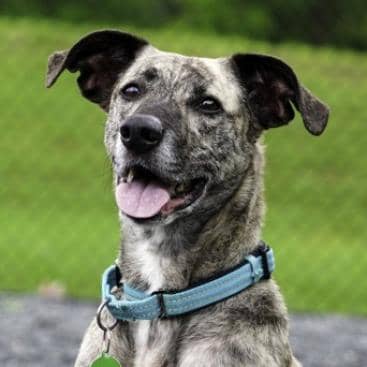What is leash “reactivity?”
Leash “reactivity” is more than just an overly excited dog, more than a dog that doesn’t have loose leash walking skills, and more than an owner that can’t “handle their dog.” The roots of leash “reactivity” typically stem from barrier frustration. Barrier frustration is an average coping mechanism when a dog cannot participate in standard dog greeting etiquette. If given the opportunity, most social and dog-friendly dogs would greet one another politely, circularly, nose-to-bum manner. When we put our dogs on leash and take them for a walk, we prohibit them from greeting appropriately, interacting as desired, or even fleeing a scary situation. In turn, our dogs may begin to respond to the sight of other people or dogs in an exaggerated, frustrated, defensive, or overly “aroused” manner. If allowed to continue rehearsing these undesired behaviors on a leash, the frustrations may continue to grow, the intensity may rise, and the frequency in which you see the behaviors may increase. Before our dogs can develop a routine of barking, pulling, lunging, or growling every time they see another dog or person, let’s help manage the situation while addressing their current emotions.
There are a few tools and techniques available to help our leash “reactive” dogs, some of which include:
Front Clip Harnesses – By fitting your dog in a body harness, you will decrease the pressure on their sensitive neck areas when pulling and, in turn, gain more control of your dog when walking on the leash. Our favorite harness is the Freedom No-Pull Harness, which provides two contact places for additional support. Other popular front clip harnesses include the Balance Harness, Easy Walk, Sensation, and Sensible. We recommend trying a few on your dog and seeing which you feel offers the most comfort and control.
Head Halters. Head Halters work similarly to front clip harnesses, as they help manage to pull behavior. When a head halter is appropriately fitted, it will gently position the dog’s head back towards the handler when pulling ahead or having tension on the leash. Be sure to follow the desensitization protocol with most head halters to ensure your dog is comfortable wearing one. A few head halters are Newtrix, Halti, and Gentle Leader.
You should NEVER use head halters to jerk a dog’s head, “correct” an undesired behavior, or pull the dog away from something. Using the head halter can increase the likelihood of injury, create a negative association with the equipment, increase fear and anxiety, and break the trust between dog and handler.
Be your dog’s advocate. If someone on the street continues to approach their dog because their dog “is friendly,” ask for some space! Explain that your dog is not ready to meet other dogs on leash, or say “no thanks!” By being their advocates, they will not be forced into undesired situations that may increase the chances of heightened frustration, fear, or “arousal.”
Avoid, avoid, avoid. We know it can be hard sometimes to be 100% focused on your surroundings, but if you can spot a dog BEFORE your dog does, you will be able to redirect their focus, cross the street, walk the other way, hide behind a car or bush, etc. If your neighborhood is highly dog populated, try getting your pup out for his daily walks during hours with less foot traffic or try less popular streets. By avoiding the chances of having a dog-dog run-in, you are setting your dog up for success, preventing them from rehearsing the undesired behaviors, and allowing for a more comfortable and enjoyable walk for all parties involved.
How to change their emotional response
In combination with the management tools listed above, it is recommended that you also start working on developing positive associations with seeing other dogs on leash. This requires consistently and frequently delivering “good things” like delicious treats every time your dog looks at another. This can take time, patience, and skill to be done effectively. There are many factors to take into account, such as:
- Does my dog react to EVERY dog? Or is it just a specific breed, size, or age?
- Is my dog suffering from barrier frustration due to fear, excitement, or possibly as a threat?
- Does my dog do well with other dogs when OFF leash?
- At what point does the “reactivity” take effect? What is my dog’s threshold? As I am sure, you can now see, so many complicated factors may be involved in your dog’s “reactivity.”
To ensure that your dog is building a positive emotional response and that you are using the correct methods to control your dog’s “reactivity,” it is highly recommended that you seek professional guidance.



